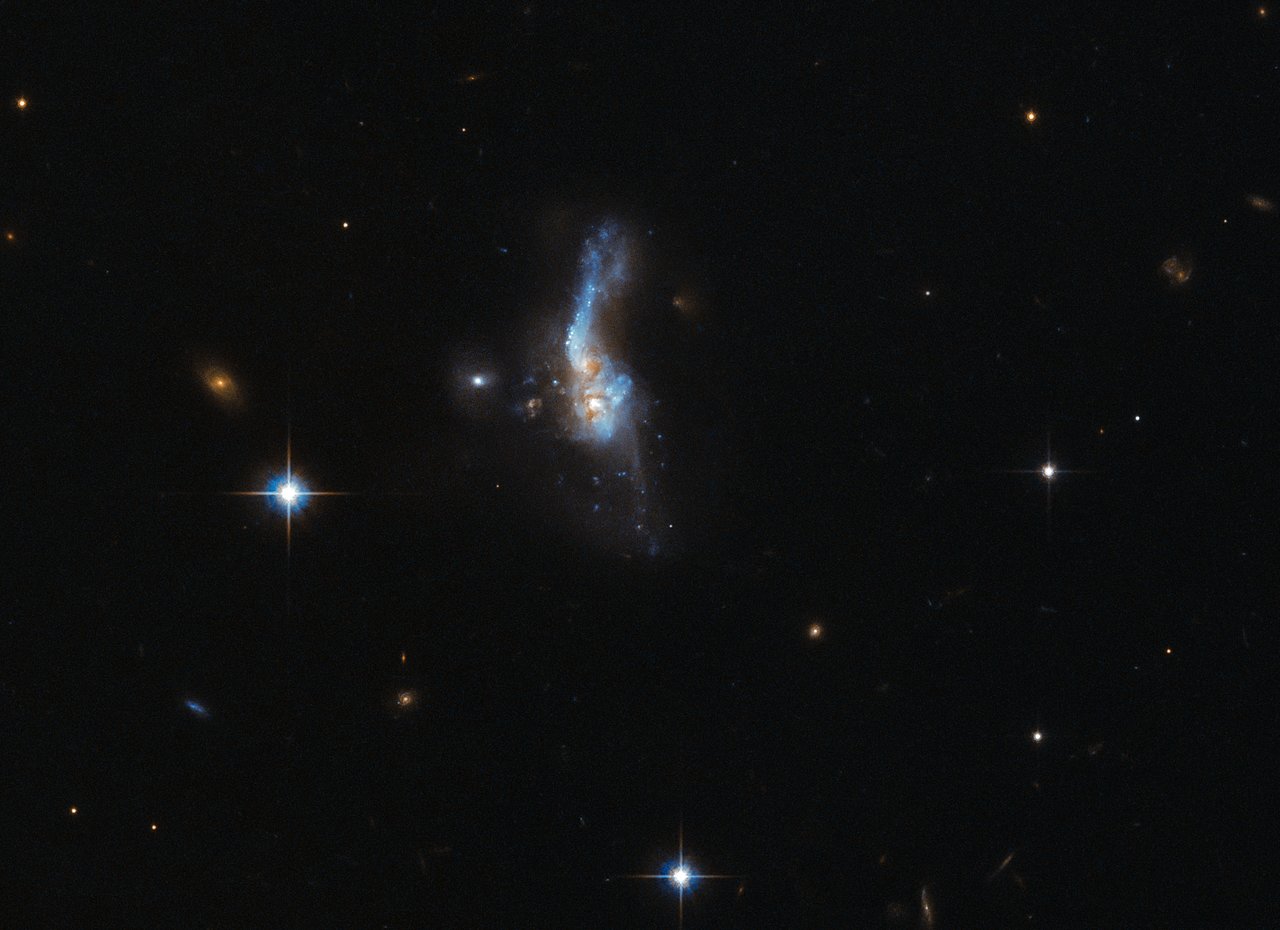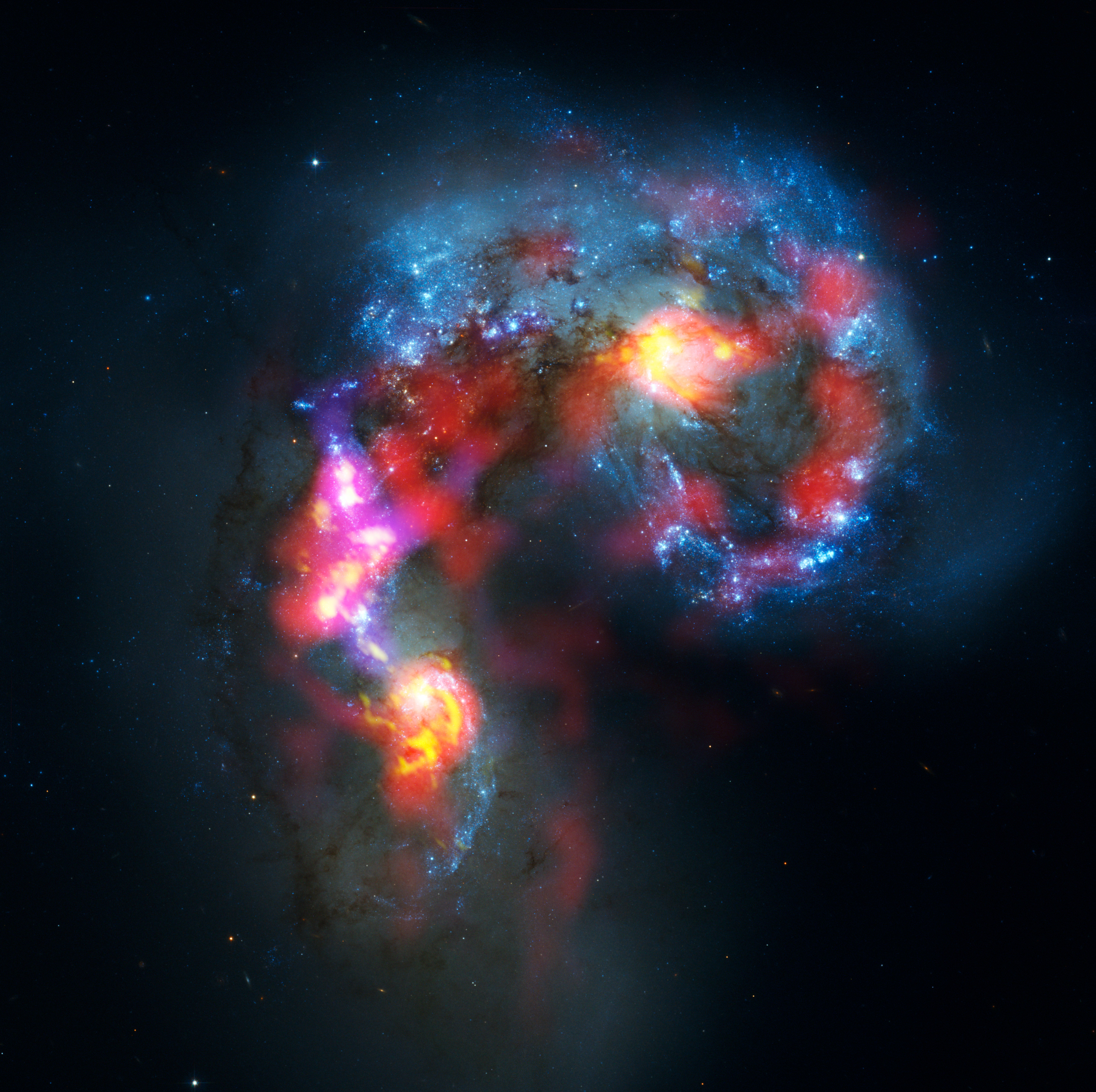|
Arp 299
Arp 299 (parts of it are also known as IC 694 and NGC 3690) is a pair of colliding galaxies approximately 134 million light-years away in the constellation Ursa Major. Both of the galaxies involved in the collision are barred irregular galaxies. It is not completely clear which object is historically called ''IC 694''. According to some sources, the small appendage more than an arcminute northwest of the main pair is actually IC 694, not the primary (eastern) companion. The interaction of the two galaxies in Arp 299 produced young powerful starburst regions similar to those seen in II Zw 96. Nine supernovae have been detected in Arp 299: SN 1992bu, SN 1993G, SN 1998T, SN 1999D, SN 2020fkb, SN 2022gnp were observed in NGC 3690 while SN 2005U, SN 2010O and SN 2010P were observed in IC 694.2010O in NGC 3690 (David Bi ... [...More Info...] [...Related Items...] OR: [Wikipedia] [Google] [Baidu] |
Atlas Of Peculiar Galaxies
The ''Atlas of Peculiar Galaxies'' is a catalog of peculiar galaxies produced by Halton Arp in 1966. A total of 338 galaxies are presented in the atlas, which was originally published in 1966 by the California Institute of Technology. The primary goal of the catalog was to present photographs of examples of the different kinds of peculiar structures found among galaxies. (online version, including Arp's original tabular data, and PDF link) Background Arp realized that the reason why galaxies formed into spiral or elliptical shapes was not well understood. He perceived peculiar galaxies as small "experiments" that astronomers could use to understand the physical processes that distort spiral or elliptical galaxies. With this atlas, astronomers had a sample of peculiar galaxies that they could study in more detail. The atlas does not present a complete overview of every peculiar galaxy in the sky but instead provides examples of the different phenomena as observed in nearby ga ... [...More Info...] [...Related Items...] OR: [Wikipedia] [Google] [Baidu] |
NGC Objects
The ''New General Catalogue of Nebulae and Clusters of Stars'' (abbreviated NGC) is an astronomical catalogue of deep-sky objects compiled by John Louis Emil Dreyer in 1888. The NGC contains 7,840 objects, including galaxies, star clusters and emission nebulae. Dreyer published two supplements to the NGC in 1895 and 1908, known as the ''Index Catalogues'' (abbreviated IC), describing a further 5,386 astronomical objects. Thousands of these objects are best known by their NGC or IC numbers, which remain in widespread use. The NGC expanded and consolidated the cataloguing work of William and Caroline Herschel, and John Herschel's ''General Catalogue of Nebulae and Clusters of Stars''. Objects south of the celestial equator are catalogued somewhat less thoroughly, but many were included based on observation by John Herschel or James Dunlop. The NGC contained multiple errors, but attempts to eliminate them were made by the ''Revised New General Catalogue'' (RNGC) by Jack W. Sulenti ... [...More Info...] [...Related Items...] OR: [Wikipedia] [Google] [Baidu] |
Luminous Infrared Galaxies
Luminous infrared galaxies or LIRGs are galaxies with luminosities, the measurement of brightness, above . They are also referred to as submillimeter galaxies (SMGs) through their normal method of detection. LIRGs are more abundant than starburst galaxies, Seyfert galaxies and quasi-stellar objects at comparable luminosity. Infrared galaxies emit more energy in the infrared than at all other wavelengths combined. A LIRG's luminosity is 100 billion times that of the Sun. Galaxies with luminosities above are ultraluminous infrared galaxies (ULIRGs). Galaxies exceeding are characterised as hyper-luminous infrared galaxies (HyLIRGs). Those exceeding are extremely luminous infrared galaxies (ELIRGs). Many of the LIRGs and ULIRGs are showing interactions and disruptions. Many of these types of galaxies spawn about 100 new stars a year as compared to the Milky Way which spawns one a year; this helps create the high level of luminosity. Discovery and characteristics Infrared galaxie ... [...More Info...] [...Related Items...] OR: [Wikipedia] [Google] [Baidu] |
Peculiar Galaxies
A peculiar galaxy is a galaxy of unusual size, shape, or composition. Between five and ten percent of known galaxies are categorized as peculiar. Astronomers have identified two types of peculiar galaxies: ''interacting galaxies'' and ''active galactic nuclei'' (AGN). When two galaxies come close to each other, their mutual gravitational forces can cause them to acquire highly irregular shapes. The terms 'peculiar galaxy' and 'interacting galaxy' have now become synonymous because the majority of peculiar galaxies attribute their forms to such gravitational forces. Formation Scientists hypothesize that many peculiar galaxies are formed by the collision of two or more galaxies. As such, peculiar galaxies tend to host more active galactic nuclei than normal galaxies, indicating that they contain supermassive black holes. Many peculiar galaxies experience starbursts, or episodes of rapid star formation, due to the galaxies merging. The periods of elevated star formation and the l ... [...More Info...] [...Related Items...] OR: [Wikipedia] [Google] [Baidu] |
Barred Irregular Galaxies
A barred irregular galaxy is an Irregular galaxy, irregular version of a barred spiral galaxy. Examples include the Large Magellanic Cloud and NGC 6822. Some barred irregular galaxies (like the Large Magellanic Cloud) may be Dwarf spiral galaxy, dwarf spiral galaxies, which have been distorted into an irregular shape by Galactic tide, tidal interactions with a more massive neighbor. References Barred irregular galaxies, Irregular galaxies, * Barred galaxies, * Galaxy morphological types {{galaxy-stub ... [...More Info...] [...Related Items...] OR: [Wikipedia] [Google] [Baidu] |
Interacting Galaxies
Interacting galaxies (''colliding galaxies'') are galaxies whose gravitational fields result in a disturbance of one another. An example of a minor interaction is a satellite galaxy disturbing the primary galaxy's spiral arms. An example of a major interaction is a galactic collision, which may lead to a galaxy merger. Satellite interaction A giant galaxy interacting with its satellites is common. A satellite's gravity could attract one of the primary's spiral arms. Alternatively, the secondary satellite can dive into the primary galaxy, as in the Sagittarius Dwarf Elliptical Galaxy diving into the Milky Way. That can possibly trigger a small amount of star formation. Such orphaned clusters of stars were sometimes referred to as "blue blobs" before they were recognized as stars. Galaxy collision Colliding galaxies are common during galaxy evolution. The extremely tenuous distribution of matter in galaxies means these are not collisions in the traditional sense of the w ... [...More Info...] [...Related Items...] OR: [Wikipedia] [Google] [Baidu] |
Mice Galaxies
NGC 4676, or the Mice Galaxies, are two spiral galaxies in the constellation Coma Berenices. About 290 million light-years distant, they have begun the process of colliding and merging. Their name refers to the long tails produced by tidal action—the relative difference between gravitational pulls on the near and far parts of each galaxy—known here as a galactic tide. It is a possibility that both galaxies, which are members of the Coma Cluster, have experienced collision, and will continue colliding until they coalesce. The colors of the galaxies are peculiar. In NGC 4676A a core with some dark markings is surrounded by a bluish white remnant of spiral arms. The tail is unusual, starting out blue and terminating in a more yellowish color, despite the fact that the beginning of each arm in virtually every spiral galaxy starts yellow and terminates in a bluish color. NGC 4676B has a yellowish core and two arcs; arm remnants underneath are bluish as well. The galaxies were ph ... [...More Info...] [...Related Items...] OR: [Wikipedia] [Google] [Baidu] |
Antennae Galaxies
The Antennae Galaxies (also known as NGC 4038/NGC 4039 or Caldwell 60/Caldwell 61) are a pair of interacting galaxy, interacting galaxies in the constellation Corvus (constellation), Corvus. They are currently going through a Starburst Galaxies, starburst phase, in which the collision of clouds of gas and dust, with entangled magnetic fields, causes rapid star formation. They were discovered by William Herschel in 1785. General information The Antennae Galaxies are undergoing a galactic collision. Located in the NGC 4038 group of galaxies, NGC 4038 group with five other galaxies, these two galaxies are known as the Antennae Galaxies because the two long tails of stars, interstellar medium, gas and dust ejected from the galaxies as a result of the collision resemble an insect, insect's antenna (biology), antennae. The galaxy nucleus, nuclei of the two galaxies are joining to become one giant galaxy. Most galaxies probably undergo at least one significant collision in their li ... [...More Info...] [...Related Items...] OR: [Wikipedia] [Google] [Baidu] |





